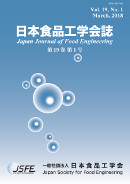
- Issue 4 Pages 191-
- Issue 3 Pages 137-
- Issue 2 Pages 57-
- Issue 1 Pages 1-
- |<
- <
- 1
- >
- >|
-
Ratchanon CHANTANUSON, Jian Long ZHU, Yayoi MIYAGAWA, Hidefumi YOSHII, ...2018 Volume 19 Issue 4 Pages 191-196
Published: December 15, 2018
Released on J-STAGE: December 26, 2018
JOURNAL FREE ACCESSA simple and cheap method for estimating the glass transition temperature (Tg) of powders was proposed. This involved measuring the discoloration process of a dye added to the powders under temperature-programmed heating conditions. The method was applied to evaluate the Tg values of mixtures of maltodextrin and fructose, containing betanin, a natural dye. The Tg values obtained by this method almost agreed with those calculated by the Couchman and Karasz equation using the Tg values for constituents in the mixture, thus indicating the validity of the method.
View full abstractDownload PDF (780K) -
Toshio NAKAI, Naoki KAMI, Mika FUKUOKA, Noboru SAKAI2018 Volume 19 Issue 4 Pages 199-207
Published: December 15, 2018
Released on J-STAGE: December 26, 2018
JOURNAL FREE ACCESSToward the goal of obtaining high-quality pasteurized whole eggs, we tested ohmic heating. The characteristic uneven temperature distribution was confirmed during the ohmic heating of a single whole egg at 20 kHz. The electrical properties of each constituent of whole egg and its arrangement with respect to the direction of the current might influence the heating rate during ohmic heating. We therefore measured the temperature dependence of the electrical properties of egg white, yolk (with and without yolk membrane), and liquid whole egg from 10℃ to 90℃ with an ohmic heating system and an LCR meter. All conductivities increased exponentially with the increase in temperature. In the high-frequency range of 20 kHz, the resistance became smaller than that of the low-frequency range (50/60 Hz), and the variation in resistance disappeared. The conductivity of the egg yolk membrane was remarkably low at 0.12 S・m-1 at 50℃, indicating that the egg yolk membrane has a great influence on the ohmic heating characteristics of the whole egg. Our findings thus demonstrate the possibility of the high-quality pasteurization of whole eggs by ohmic heating.
View full abstractDownload PDF (1853K)
- |<
- <
- 1
- >
- >|